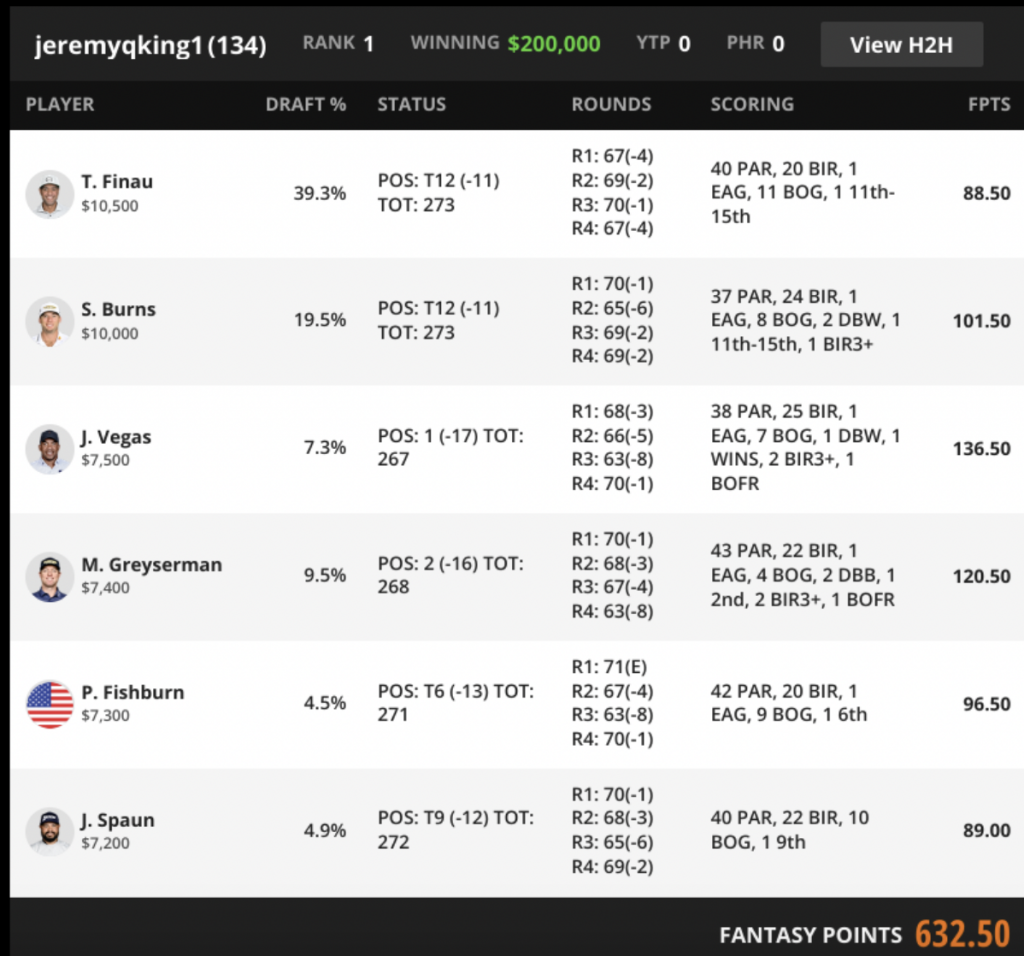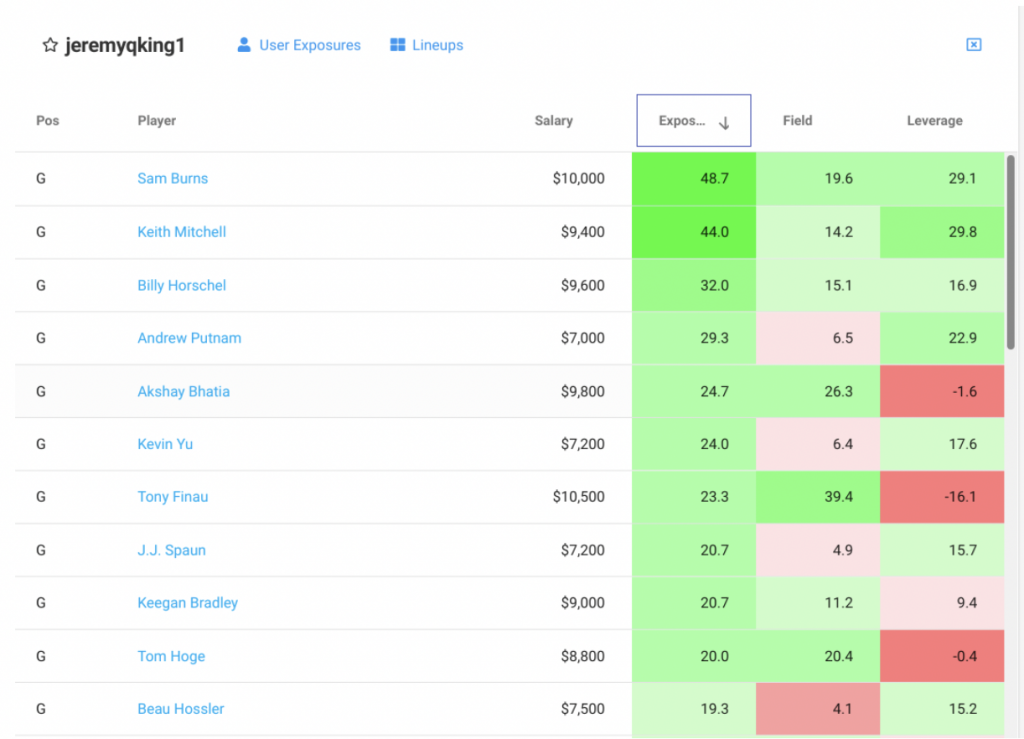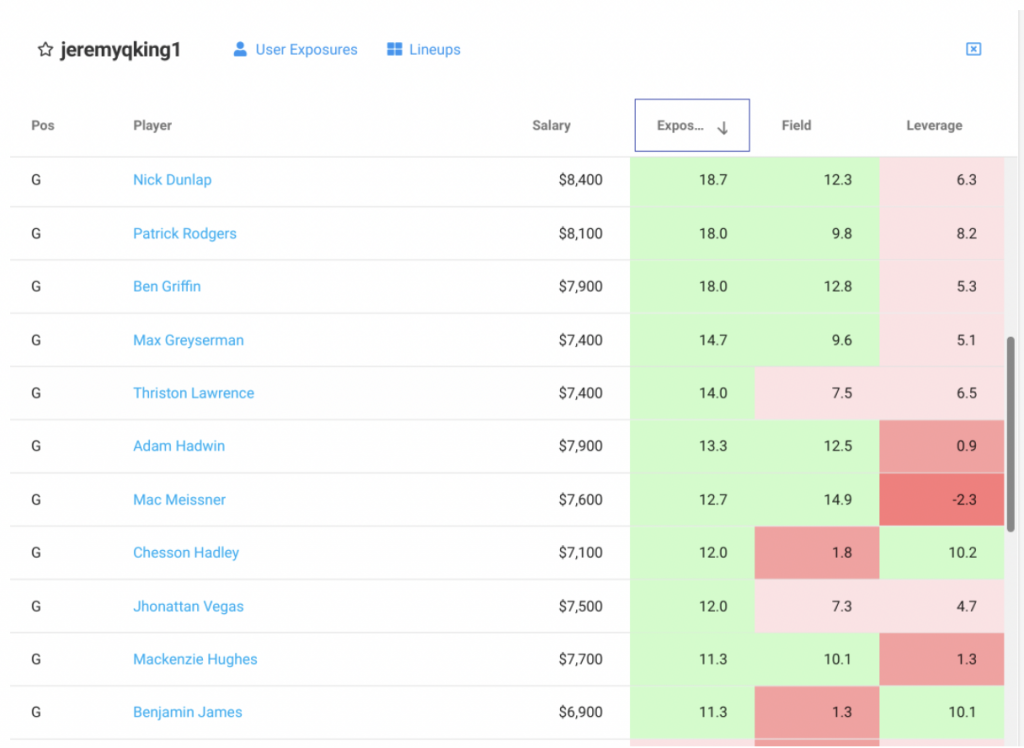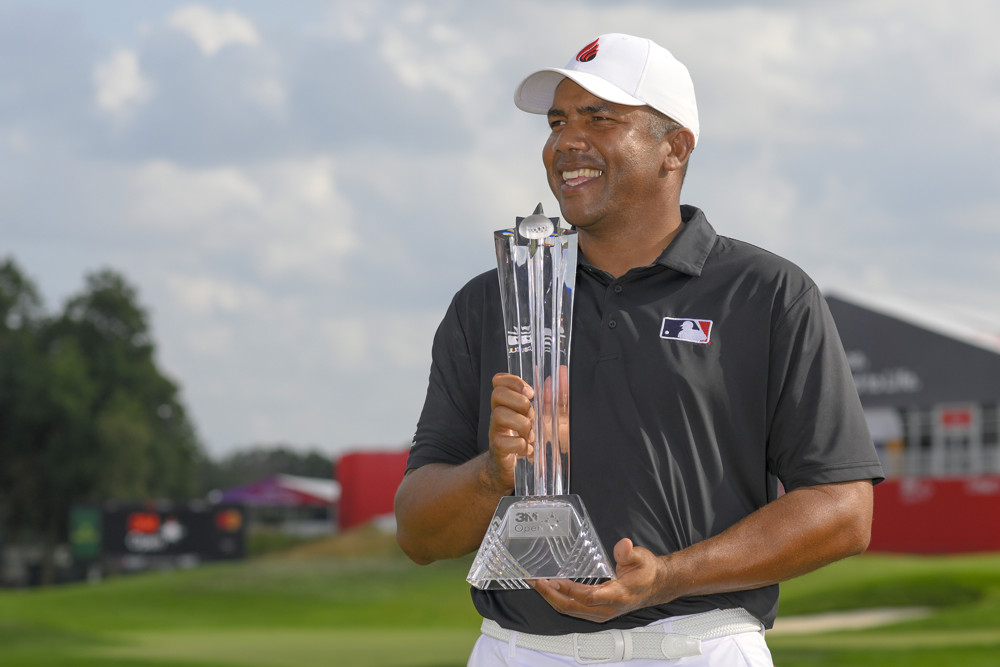Just as our Adam Levitan does each week during the NFL season, every Monday we’ll be using the week-long nature of DFS golf to take advantage of the extended feedback loop by analyzing what went right and what went wrong in the previous week’s slate, regardless of results.
Each week, we’ll review a variety of cash-game & GPP lineups in an effort to take you inside our thought process as we approached Thursday’s lock and how our projection- and ownership-based expectations stacked up against the field.
This week, you all get a special edition of the Golf Lineup Review from me, as all it takes is winning the flagship GPP to get an extra reward. That extra reward? Making me write an extra article on the week and appear on Establish The Green as well. Adam Levitan, ladies and gentlemen — a true delegator. For this Golf Lineup Review, I’ll be reviewing my winning lineup from the $200K-to-first Sand Trap, of course. But, I’ll also be reviewing my MME set in general, because reviewing one lineup out of 150 is a bit tough when you’re working with an optimizer like The SOLVER.
Draftkings Large-Field Tournament

I’ll start with talking about this lineup in particular and then move on to my thoughts about my MME set. As a reminder, the $800K Summer Sand Trap has a 25%-to-first prize, with about 45K entries in the contest. One of the things I constantly talk about in the Large-Field GPP Breakdown I write every week is roster construction.
Thankfully, the lineup I actually won with featured some of the roster construction tips that I talked about in my article, so it’s great to see some of my writing in action! Starting with Tony Finau and Sam Burns up top immediately made me a bit different than the field, with that combo coming in at 3.87% owned in the contest. Because of the double-tap at $10K+, that forced me to drop down into the $7Ks and fully skip the $8K and $9K ranges out of necessity. I landed on four players that I liked in the $7K range — with three of them being on Sky’s Value Report from last week (J.J. Spaun, Max Greyserman, and Patrick Fishburn). Jhonattan Vegas was a player I have been taking chances on this whole year, given he was quite a good player prior to injury and seems to fit these birdie fest-type courses pretty well.
Now, let’s dive a bit into my MME set, which is pictured below.


Just below Ben James is Patrick Fishburn, who I had about 8% exposure to in my MME set. The funny part about all of this is that my MME set only cashed 17 lineups out of 150, so I definitely had to sun-run a bit to take down the top prize. That being said, I do like to think that I’m setting my lineups up to have the best shot at rising to the top. I try and comb through my lineups after running through The SOLVER in order to ensure I’m getting unique roster constructions and combinations to maximize the limited 150 set I have.
As I mentioned in the Large-Field GPP Breakdown, I thought most of the options in the upper price ranges were pretty good plays, but I actually felt like Tony Finau was going to come in a bit over-owned. One thing that I mentioned on Establish The Green was that due to name value and DFS players wanting to fill their lineups with salary, I thought that Finau might actually come in a bit higher in ownership. That turned out to be true with Tony coming in at 39.5% ownership in the Sand Trap. When those cards flipped, I was quite happy with my 50% Burns position (against 19% field) and 22% Finau position, almost half the field. What made me even happier was that I set up The SOLVER to boost Finau and Burns in lineups with each other, resulting in almost HALF of my Finau lineups coming with Burns in them as well.
I’ll elaborate more on my Finau thoughts in this next paragraph. There were really two players that I absolutely did not want to pair Finau with — Akshay Bhatia and Austin Eckroat. Both Finau/Akshay and Finau/Eckroat combinations came in over 5.5% owned in the Sand Trap, and I was especially wary of the latter given the price-point combinations. In The SOLVER, I employed a max-1 of Finau/Eckroat (I had about 5% Eckroat total), and the boost with Burns allowed me to direct almost all of my Finau lineups in stars-and-scrubs builds. With these modifications in place, I felt like I was really maximizing the effectiveness of my Finau lineups despite being almost half the field in terms of exposure in my set. If you are playing a 150 MME set, thinking in this way about expensive chalk can allow you to take underweight positions that you are comfortable about without giving up too many lineups.
As you can see from my exposures above, my exposures were littered with overweight positions on a ton of different $7K players. I wouldn’t be surprised if most of the Burns/Finau lineups that I had just filtered through different foursomes of $7K players much like the winning lineup posted above. Again, this illustrates me playing Tony Finau in a very distinct fashion and hoping that these unique combinations will win out if Finau indeed was in the winning lineup. Luckily enough for me, the combination of four above ended up in a lineup together. This is the beauty of being able to play a 150 set — filling out your general roster construction concepts with a variety of different combinations allows you to cover your bases if you are correct! I apply similar types of concepts when we talk about R4 showdown as well!
In my non-Finau lineups, I didn’t have to do too many crazy things. Akshay Bhatia was the one player who I thought might get out of hand in terms of ownership, and I also employed a max-1 Bhatia/Eckroat rule as well. I employed a ton of different boosts in the $9K range, which allowed me to get a ton of three $9K players in a single lineup. Even slight boosts like 1-2% on players will make a difference, trust me. These “three $9K” lineups made up about 30% of my lineups overall.
In the $8K range, there were really only three players that I was super interested in: Tom Hoge, Nick Dunlap, and Patrick Rodgers. I didn’t do anything super special with these players overall, employing them in pretty normal builds because I wasn’t too worried about their individual ownerships. Given that I was starting a lot of these normal builds with Burns (19%), Horschel (15%), and Mitchell (12%), this felt okay with me in my portfolio. I think this is a very important thing to point out: You don’t necessarily need to have every single one of your lineups with some “unique” type of construction. It depends on the players you’re playing in it to get the overall lineup’s product and cumulative ownership.
If you’re keeping track at home, you probably have an idea now of what my MME set looked like — a subset of it was Finau/Burns starts, another subset of it was three $9K builds, and another subset was mostly normal builds with unique starts up top and on the bottom as well (given my fades of Kurt Kitayama and Austin Eckroat). I felt confident about this type of overall MME set going in, which of course was blown up by the post-lock Billy Horschel WD.
Now that we’ve gone through my overall MME set, I’ll leave you with a single sentence that I think defines my process:
Combining my management of individual player ownership with my overall roster construction management thoughts allows me to feel confident that I am playing highly-projected lineups in unique ways.
Alright! I think that was a pretty sufficient overview of my MME process and how that resulted in the winning Sand Trap lineup for the week! If there’s something I really love, it’s picking up the slack for my dear co-workers, Cody Main and Sky, which I’ll be doing a couple of times this week apparently! Catch you all on Establish The Green on Wednesday and in Discord. And as always, definitely check out the Large-Field GPP Breakdown on Wednesday as well for the Olympics!



